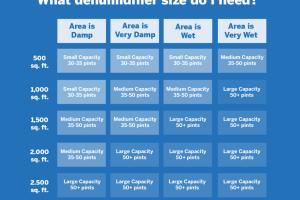Ultimate Guide: How to Choose the Right Size Dehumidifier for Your Home

-
Quick Links:
- Introduction
- Understanding Humidity
- Importance of Dehumidifiers
- Calculating Room Size
- Assessing Humidity Levels
- Dehumidifier Capacity
- Types of Dehumidifiers
- Dehumidifier Placement Tips
- Case Studies
- Expert Insights
- Step-by-Step Guide
- FAQs
Introduction
Choosing the right size dehumidifier is crucial for maintaining a comfortable and healthy indoor environment. A dehumidifier that is too small won’t effectively reduce moisture levels, while one that is too large might lead to excessive drying and increased energy costs. This guide aims to provide you with the necessary knowledge and tools to select the perfect dehumidifier size for your home.
Understanding Humidity
Humidity refers to the amount of moisture in the air. It is measured in percentage, where 0% means the air is completely dry, and 100% means it is fully saturated with water vapor. Understanding humidity is essential as it affects indoor air quality, comfort levels, and even the structural integrity of your home.
Types of Humidity
- Absolute Humidity: The actual amount of moisture in the air, expressed in grams per cubic meter.
- Relative Humidity: A percentage that indicates how much moisture is currently in the air compared to the maximum amount it could hold at a given temperature.
Importance of Dehumidifiers
Dehumidifiers play a significant role in maintaining a healthy indoor environment. They help to:
- Prevent mold and mildew growth.
- Reduce allergens such as dust mites.
- Improve overall air quality.
- Protect furniture and belongings from moisture damage.
- Enhance comfort by reducing sticky, humid conditions.
Calculating Room Size
Before choosing a dehumidifier, it’s essential to calculate the size of the room where it will be used. Measure the length and width of the room and multiply these dimensions to find the square footage.
Example Calculation
If your room is 20 feet long and 15 feet wide, the calculation would be:
20 feet x 15 feet = 300 square feet
Assessing Humidity Levels
To determine the required capacity of your dehumidifier, assess the humidity levels in your space. You can use a hygrometer to measure the relative humidity. Ideal indoor humidity typically falls between 30-50%.
Identifying Problem Areas
Common areas that may require additional dehumidification include:
- Basements
- Bathrooms
- Kitchens
- Areas with poor ventilation
Dehumidifier Capacity
Dehumidifiers are rated by the amount of moisture they can remove from the air in 24 hours, usually expressed in pints. Choosing the right capacity is essential based on your room size and humidity level.
Recommended Capacities
| Room Size (sq ft) | Humidity Level | Dehumidifier Capacity (pints/day) |
|---|---|---|
| 300 | High | 30-50 |
| 500 | Moderate | 50-70 |
| 1000 | High | 70-90 |
Types of Dehumidifiers
There are several types of dehumidifiers, each suitable for different environments:
- Refrigerant Dehumidifiers: Best for warm, humid climates; they work by cooling the air and condensing moisture.
- Desiccant Dehumidifiers: Use moisture-absorbing materials; ideal for cold areas.
- Whole-House Dehumidifiers: Designed to work with your HVAC system for comprehensive moisture control.
Dehumidifier Placement Tips
Proper placement of your dehumidifier is crucial for optimal performance. Consider the following tips:
- Place the unit in the most humid area of the room.
- Ensure there’s enough space around the unit for air circulation.
- Avoid placing it near walls or furniture.
Case Studies
We spoke with homeowners who have successfully chosen the right size dehumidifier:
- Case Study 1: A family in a humid climate opted for a 70-pint dehumidifier for their basement, successfully reducing humidity levels from 80% to 45%.
- Case Study 2: A couple in a dry area found that a smaller 30-pint unit was sufficient for their 500 sq ft bedroom, improving air quality significantly.
Expert Insights
Experts recommend considering both room size and humidity levels when selecting a dehumidifier. “It’s not just about size; it’s about matching the unit to your specific environmental conditions,” says Dr. Jane Smith, an indoor air quality expert.
Step-by-Step Guide to Choosing a Dehumidifier
- Measure the room size in square feet.
- Use a hygrometer to assess humidity levels.
- Check the dehumidifier capacity recommendations based on your findings.
- Select the type of dehumidifier that best meets your needs.
- Consider placement options for optimal performance.
- Purchase the dehumidifier and set it up according to the manufacturer’s instructions.
FAQs
1. How do I know what size dehumidifier I need?
Calculate your room size and assess humidity levels. Refer to the recommended capacities based on your findings.
2. Can I use a dehumidifier in multiple rooms?
Yes, but you may need to move the unit around or consider a whole-house dehumidifier for more effective moisture control.
3. How often should I empty my dehumidifier?
This depends on the unit's capacity and humidity levels. Some models have continuous drainage options.
4. What happens if my dehumidifier is too small?
A smaller unit may not effectively reduce humidity levels, leading to ongoing moisture issues.
5. What if my dehumidifier is too large?
It may lead to over-drying the air, causing discomfort and potential damage to wooden furniture.
6. Are there energy-efficient dehumidifiers?
Yes, look for units with Energy Star rating to save on energy costs.
7. How do I maintain my dehumidifier?
Regularly clean the filter and water reservoir, and check for any signs of wear.
8. Can dehumidifiers help with allergies?
Yes, by reducing humidity, they can help minimize dust mites and mold, improving air quality for allergy sufferers.
9. What is the ideal humidity level for a home?
The ideal range is between 30-50% relative humidity.
10. How long will a dehumidifier last?
With proper maintenance, most dehumidifiers last between 5-10 years.
Random Reads